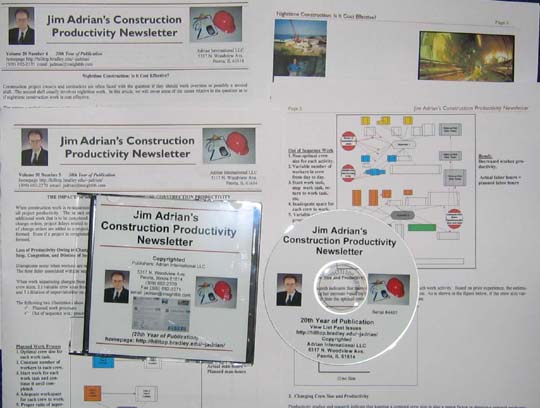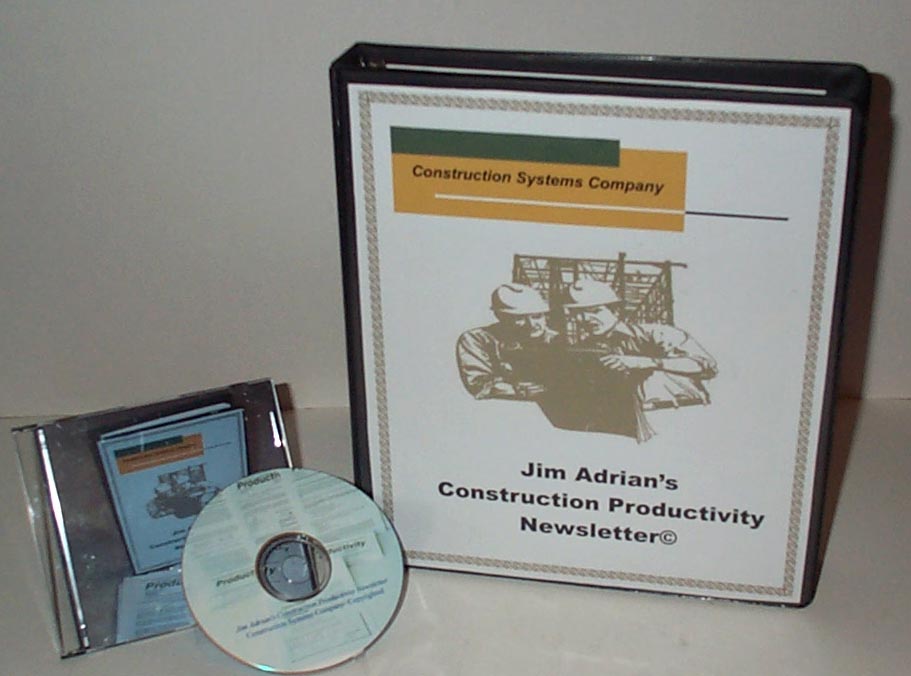|  Vol. 12
No.6 Improving Construction Productivity (Part 1)
Vol. 12
No.6 Improving Construction Productivity (Part 1)  Vol.
13 No.1 Improving Construction
Productivity (Part 2) Vol.
13 No.1 Improving Construction
Productivity (Part 2)  Vol.
13
No.2 Improving Construction
Productivity (Part 3) Vol.
13
No.2 Improving Construction
Productivity (Part 3)
 Vol.
13.
No.3 Planning a Productive Jobsite Layout Vol.
13.
No.3 Planning a Productive Jobsite Layout  Vol. 13 No.4 Measuring Productivity
Benefits Vol. 13 No.4 Measuring Productivity
Benefits
 Vol. 13
No.5 Vol. 13
No.5
The
Ten
Deadly Signs of the Construction
Process:Aiming for Zero Defects  Vol. 13 No.6 Vol. 13 No.6
The Effective
Supervisor:
A Manager of Cost, Time, and Risk Considerations  Vol. 14 No.1
Quantification of Lost Productivity Vol. 14 No.1
Quantification of Lost Productivity  Vol. 14 No. 2 Benchmarking: A
Key Element to Improving A Process Vol. 14 No. 2 Benchmarking: A
Key Element to Improving A Process  Vol. 14 No. 3 Improving
Construction Productivity by Risk Analysis and Process Analysis Vol. 14 No. 3 Improving
Construction Productivity by Risk Analysis and Process Analysis
 Vol.14 No.
4 Vol.14 No.
4
Total Quality Management (TQM) Defined  Vol. 14 No. 5 Vol. 14 No. 5
The Effective Construction Supervisor
 Vol. 14 No.6 Vol. 14 No.6
MORE: A New Approach to Improving Construction Productivity
 Vol. 15
No. 1 Vol. 15
No. 1
Using the Cost Method to Prove Lost Productivity: The
Amp-Rite Electric Case  Vol. 15 No.2 Vol. 15 No.2
Methods of Quantifying Alleged Lost
Labor Productivity
 Vol.
15No.3 Vol.
15No.3
Types of Schedules to Illustrate Project Delay and Productivity
Impact  Vol. 15
No.4 Vol. 15
No.4
Critiquing the Firm's Estimating and Scheduling
Process
 Vol. 15 No.
5 Vol. 15 No.
5
Critiquing the Firm's Control System and Productivity
Program
 Vol. 15 No.
6 Vol. 15 No.
6
Acceleration of the Construction Process: Impact on
Productivity
 Vol. 16 No.
1 Vol. 16 No.
1
Increasing Construction Equipment Productivity (Part 1)  Vol. 16 No. 2 Vol. 16 No. 2
A Ten Point
Program to Increase
Construction Equipment Productivity (Part 2)
 Vol. 16 No. 3 Vol. 16 No. 3
New Job Site Signs to Increase Productivity
 Vol. 16
No. 4 Vol. 16
No. 4
Improving Productivity by Use of Profit Centers
 Vol. 16 No. 5 Vol. 16 No. 5
Understanding a
Worker's Ability to Do Work  Vol. 16 No. 6 Vol. 16 No. 6
Challenging the Work Process
for Improvement
 Vol. 17 No.
1 Vol. 17 No.
1
Scheduling to Improve Productivity: Part 1  Vol.17 No. 2 Vol.17 No. 2
Scheduling to Improve
Productivity: Part 2
|
 Vol. 17
No. 3 Vol. 17
No. 3
Scheduling to Improve Productivity: Part 3 Vol. 17 No. 4 Vol. 17 No. 4
Using the Dormant
Phase: Preplanning to Increase Productivity
 Vol. 17 No. 5 Vol. 17 No. 5
Improving Construction
Productivity by Eliminating a Defect
 Vol. 17 No. 6 Vol. 17 No. 6
Ten Reasons Why You
Should Encourage Your Son or Daughter to be a Construction
Supervisor
 Vol. 18 No.
1 Vol. 18 No.
1
Selecting the Most Productive Use of Equipment: Buy or Rent
 Vol. 18 No. 2 Vol. 18 No. 2
Change Orders:
How They Affect Time and Cost
 Vol. 18 No. 3 Vol. 18 No. 3
Implementing
New Technology to Improve Construction Productivity
 Vol. 18 No. 4 Vol. 18 No. 4
The Quality
Audit: Increasing Productivity by Adopting Consistent Practices
 Vol. 18 No. 5 Vol. 18 No. 5
Continuous
Education: The Key to Productivity Increases  Vol. 18 No. 6 Vol. 18 No. 6
Ten New Themes for Increasing
Construction Productivity: Part 1
 Vol. 19 No. 1 Vol. 19 No. 1
Ten Themes for Increasing
Construction Productivity: Part II
 Vol. 19 No. No. 2 Vol. 19 No. No. 2
Managing Subcontractors by
Encouraging Them to Manage Themselves  Vol. 19 No. 3 Vol. 19 No. 3
How Much and What Type of
Supervision is Best for Productivity Improvement
 Vol. 19 No. 4 Vol. 19 No. 4
Best Practices for Productivity
Improvement
 Vol. 19
No. 5 Vol. 19
No. 5
The Impact of Temperature on Productivity
 Vol. 19 No. 6 Vol. 19 No. 6
Loss of
Productivity Owing to the Loss of Learning
 Vol. 20 No. 1 Vol. 20 No. 1
The Seven Sins of the
Construction Process
 Vol. 20 No. 2 Vol. 20 No. 2
Gages for Measuring
Construction Productivity Defects
 Vol. 20 No. 3 Vol. 20 No. 3
Leadership Skills for
Implement Productivity Improvement
 Vol. 20 No. 4 Vol. 20 No. 4
Nighttime
Construction: Is It Cost Effective?
 Vol. 20 No. 5 Vol. 20 No. 5
The
Impact of Re-Sequenced Work on Construction Productivity
 Vol. 20 No. 6 Vol. 20 No. 6
Keeping a
Proactive Project Supervisor Resume
 Vol. 21 No. 1 Vol. 21 No. 1
A
Productivity Quiz After Twenty Years of Publication
 Vol. 21 No. 2 Vol. 21 No. 2
Five Proactive
Actions to Take When Visiting a Job Site
 Vol. 21 No. 3 Vol. 21 No. 3
Modeling
Productivity for Improvement: A Recent Example
 Vol. 21 No. 4 Vol. 21 No. 4
Implementing
a Best Practice Initiative for Productivity Improvement
|
 Vol. 21 No. 5 Vol. 21 No. 5
The Impact
of Change Orders on Project Time, Cost, and Productivity
 Vol. 21 No. 6 Vol. 21 No. 6
Planning a
Productive Supervisor Work Day
 Vol. 22 No. 1 Vol. 22 No. 1
What the
Construction Supervisor Needs to Know About Managing Change Orders: Ten
Recommendations
 Vol. 22 No. 2 Vol. 22 No. 2
The Cost of
Cold Weather Construction
 Vol. 22 No. 3 Vol. 22 No. 3
Enjoy Work:
A Philsophy for Increasing Construction Productivity
 Vol. 22 No. 4 Vol. 22 No. 4
Cumulative Disruption Impact: How to Quantify It
 Vol. 22 No.
5 Vol. 22 No.
5
Re-Engineering the Accounting System to Improvem Productivity
 Vol. 22 No.
6 Vol. 22 No.
6
To Work Overtime or Not: Charts to Help Make the Decision
 Vol. 23 No.
1 Vol. 23 No.
1
MINUTES MATTER: The Key to Productivity Improvement
 Vol. 23 No.
2 Vol. 23 No.
2
Conducting a Job Productivity Audit
 Vol. 23 No. 3 Vol. 23 No. 3
Supervision and
Leadership
 Vol. 23 No. 4 Vol. 23 No. 4
Defect
Analysis,
TQM, Six Sigma, and Lean Demystified
 Vol. 23 No. 5 Vol. 23 No. 5
Work Force
Development and Retaining Workers
 Vol. 23 No. 6 Vol. 23 No. 6
Construction
Project Control Systems: Today and Tomorrow
 Vol. 24 No. 1 Vol. 24 No. 1
Motivating Today's Workforce
 Vol. 24 No. 2 Vol. 24 No. 2
Time for Some Good News! Innovations That Have Improved Construction Productivity
 Vol. 24 No. 3 Vol. 24 No. 3
Keep Historical Productivity Data
 Vol. 24 No. 4 Vol. 24 No. 4
The Need to Focus on Productivity Versus Volume
 Vol. 24 No. 5 Vol. 24 No. 5
Perspectives on Construction Education and Productivity Improvement
 Vol. 24 No. 6 Vol. 24 No. 6
Equipment Productivity: How to Improve
 Vol. 25 No. 1 Vol. 25 No. 1
Ten Paradigms That Constrain Construction Productivity Improvement
 Vol. 25 No. 2 Vol. 25 No. 2
The Average: A
Concept that Constrains Construction Productivity Improvement
 Vol. 25 No. 3 Vol. 25 No. 3
Input
Management Versus Output Management: Revisiting a Productivity
Initiative
 Vol. 25 No. 4 Vol. 25 No. 4
Ten Fixable
Causes for Low Productivity and Project Cost Overruns
 Vol. 25 No. 5 Vol. 25 No. 5
Eliminating
Redo and Punch List Work: A Fixable Problem
 Vol. 25 No. 6 Vol. 25 No. 6
One Hundred
(100!) Things to Do to Increase Construction Productivity
|
|
 Written bimonthly for the past 25
years, readers include construction
professionals world wide.
Written bimonthly for the past 25
years, readers include construction
professionals world wide.  Vol. 17
No. 3
Vol. 17
No. 3  Annual
subscription: $68/year (hard copy).
Annual
subscription: $68/year (hard copy). Vol. 15 No.2
Vol. 15 No.2